How To Build An Environment That Supports Your Goals + Helps You Get "In Control" Of Your Cravings
Jun 07, 2022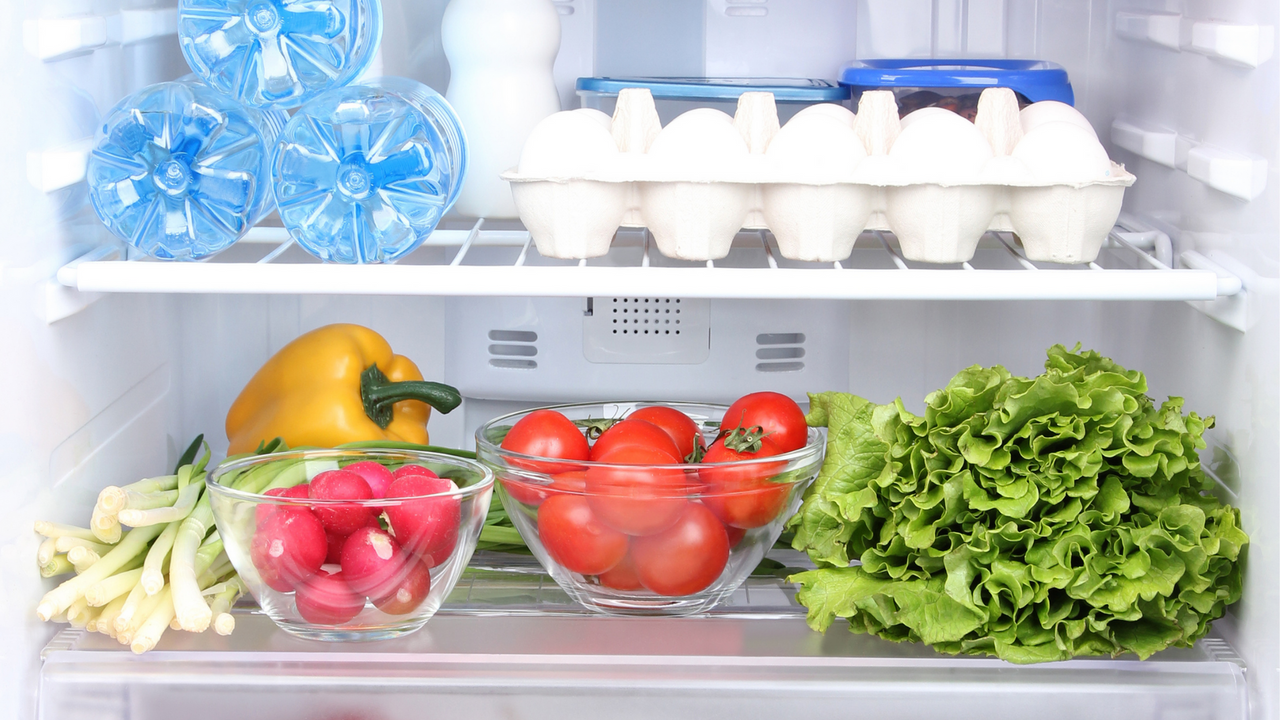
As Registered Dietitians in Saskatoon, we often hear clients express that they believe building better habits is purely a matter of willpower. We'll hear things like: “I need to get motivated to improve my nutrition habits.” And while willpower and motivation are helpful characteristics when adopting new habits, a carefully curated environment can actually have a greater impact on your success.
Imagine if your regular environments — whether your home, your office, or your social media — were crafted in ways that made supportive behaviours easier and the unsupportive behaviours harder. How often would you make aligned choices if they were simply the default response to your environment? Our nutrition coaching clients are often surprised by how much easier it is to make small adjustments to their environment than to try and motivate themselves all of the time, or even worse – feel the need to change essential parts of who they are or how they operate.
In this article and accompanying podcast, we will explore how your environment is impacting the nutrition and lifestyle choices you make, and what you can do to improve it.
Listen to the accompanying Podcast episode on environment design here.
1. Creating Supportive Cues
Every habit is initiated by a cue. You can think of a 'cue' as anything that prompts a behaviour, thought pattern, or idea. Our brains are most likely to notice cues that stand out in our physical environments. By contrast, when our home and work environment lacks specific cues for desired habits or behaviours, it can be more challenging to take a positive action (either consciously or subconsciously). Here's a few ways this dynamic might play out in your own environment:
- It's more challenging to remember to drink water when you don't have a water bottle at your desk.
- It's more challenging to eat a protein-rich breakfast when there aren't any accessible sources of protein in your fridge.
- It's more challenging to remember taking your vitamins when they are out of sight in the pantry.
When the cues that spark a habit are subtle, hidden, or absent they are easy to ignore. Thankfully, it's easier than you might think to become an architect of your environment! When you understand the habits that support your health and wellness, you can create intentional cues in your environment to make those habits easier to adopt.

As James Clear notes in his best selling book Atomic Habits, if you want to make a habit a big part of your life, it helps to make the cue a big part of your environment. Further, the most persistent behaviours are usually motivated through multiple cues! By sprinkling triggers throughout your home, office, vehicle, or other environments, you increase the odds that you’ll think about your desired habit throughout the day. Making a better decision is easier and more natural when the cues for better habits are right in front of you.
Using the examples above, our Registered Dietitians have suggested several simple re-designs to help keep cues for your desired habits front of mind:
- If you want to drink more water, leave a water bottle on your desk at work, by your bedside, or on the counter in the kitchen.
- If you want to eat protein at breakfast, do some prep ahead of time by making protein-packed overnight oats or hard-boiling eggs to grab and go.
- If you want to remember to take your vitamins, leave them in a place where you'll see them each morning such as by your toothbrush, your bedside, or your coffee maker.
Now that we understand how placing cues in our environment impacts our choices, let’s explore some specific Registered Dietitian-approved tips to make healthy eating easier:
Tip #1: Meal Prep for Success
Building supportive cues into your environment is the first step in taking action towards a desired nutrition or lifestyle habit. However, if the habit itself is difficult to execute, then you are less likely to take action. For example, if you have the goal of eating more protein at breakfast but find it takes you 30 minutes to prepare a protein source you'll enjoy, you are less likely to incorporate it into your meals long-term. This is where strategies like meal prepping can help us more easily follow-through with aligned actions, time and time again!
Most of our nutrition coaching clients in Saskatoon and Regina share that when they think of meal prep they think of portioned Tupperware containers with rice, steamed broccoli, and boiled chicken - boring! This definitely isn't Vitality Nutrition's approach to meal prep. For our team of Registered Dietitians, meal prep can simply mean having a few ingredients prepped ahead of time that will make a fresh meal come together more easily or can offer you a few options for grab-and-go snacks. For example:
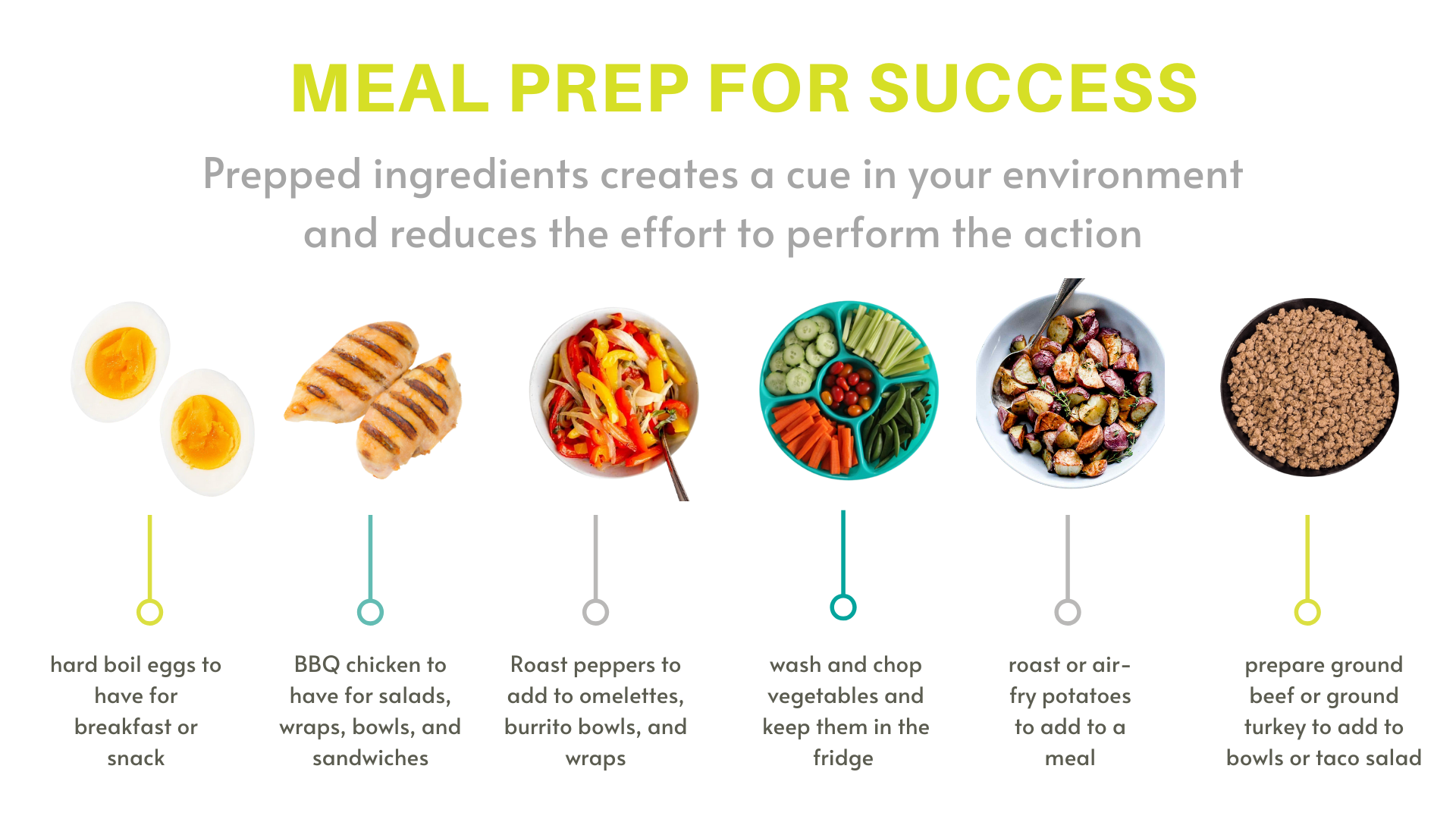
Other nutrition coaching clients find it supportive to use meal prep services like Hello Fresh or Chef’s Plate. Having these ready-to-make meals in the fridge becomes a cue in their environment, and the prepped ingredients and clear recipe instructions reduce the effort required to follow through with the action of cooking. If we return to the concept of building supportive cues into our environment, the prepped food becomes a cue to make a homemade meal that is quick and balanced!
Tip #2: Utilize Convenience Foods
When our nutrition coaching clients hear the word 'convenience foods' they often think of chips, soda, candies, and chocolates. However, foods that are convenient can also be nutrient-dense choices that simply have a bit more 'work' done to them before they hit your grocery basket, making them less work to cook or consume. By storing these convenient items in your fridge, freezer, and pantry you'll have access to ingredients that help you build quick, delicious, and nutritious meals. This not only creates a cue in the environment but the effort required to follow through with the action of eating something nutritious is decreased.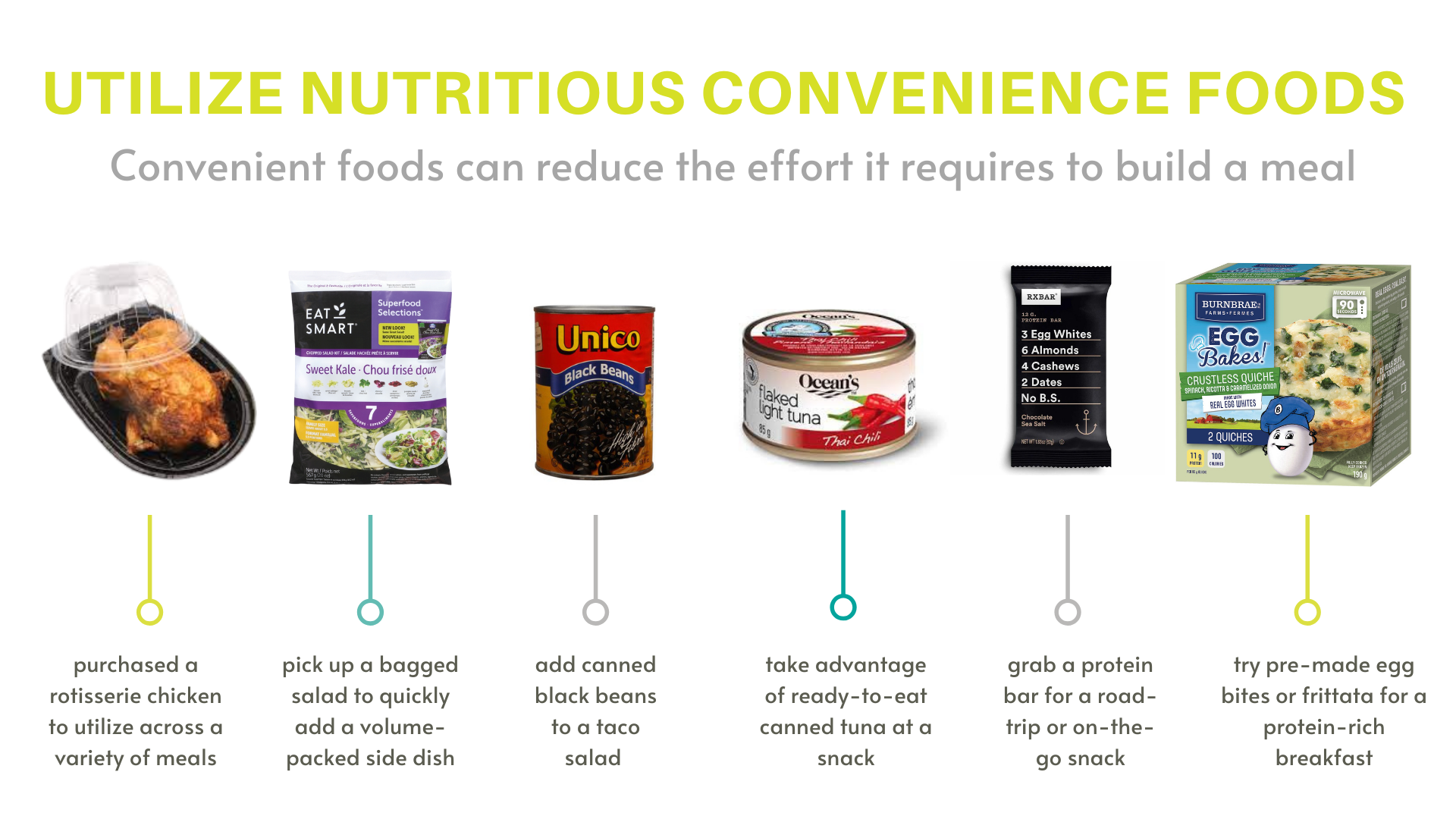
Tip #3: You Eat What You See
As discussed, the cues in our environment trigger the habit (and the actions!) we take in our lives. So, if there are foods a Registered Dietitian has recommended you consume more of – like vegetables, fruits, proteins, whole grains, and healthy fats – then consider how you can make these items more visible in your environment. For example:
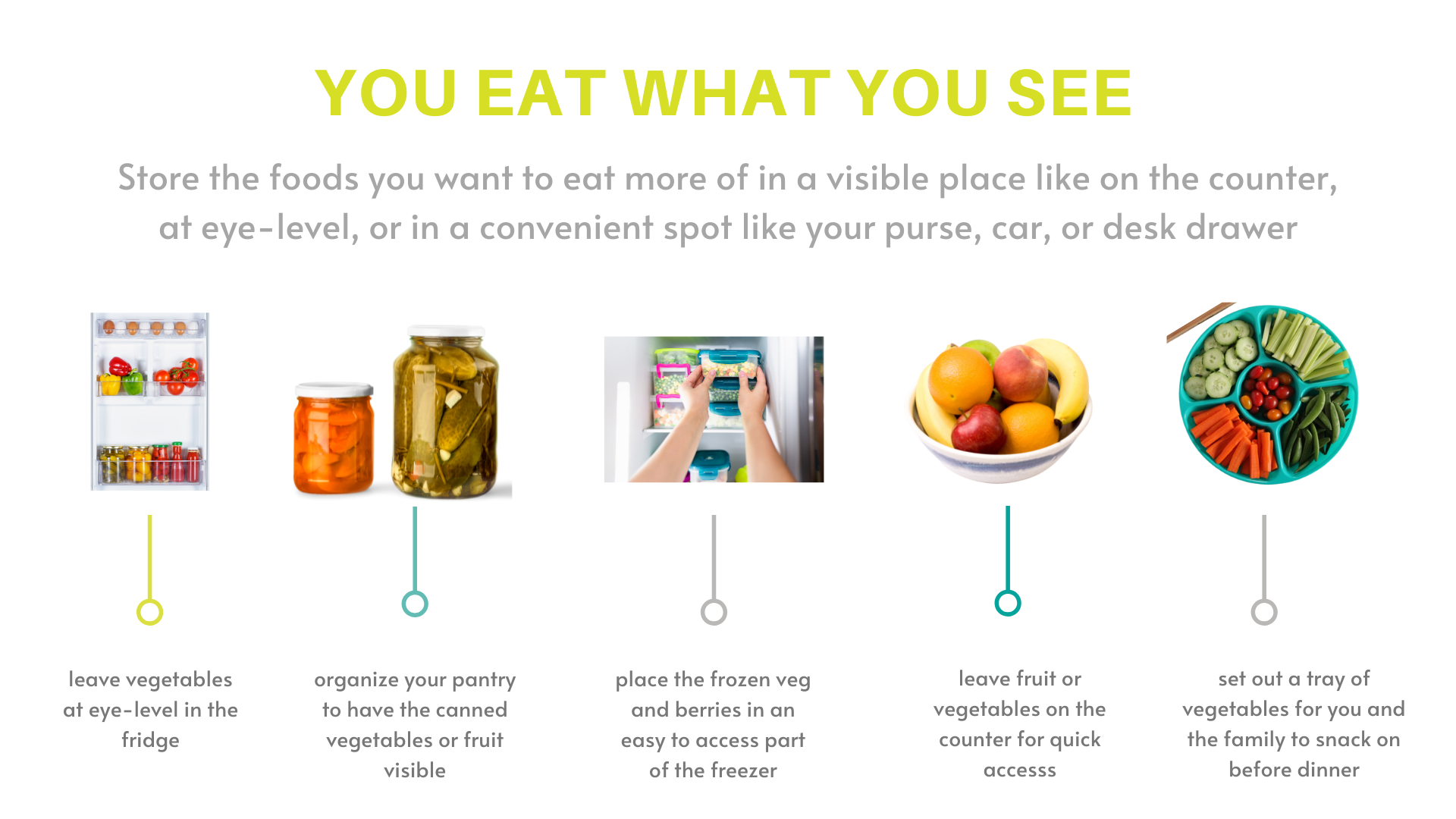
Tip #4: Out of Sight, Out of Mind
As discussed later in the article, our team of Registered Dietitians don’t recommend completely eliminating foods from your environment. However, if there is a food you find yourself mindlessly grazing on and you think you might feel better consuming it less often (or in a more intentional way), then it could be worth considering your environmental design.
For example, if the potato chips are the first thing you see when you open the pantry, it makes sense that you’d choose them when you get home from work and feel famished. Instead, you might put them on the top shelf of the pantry so they are less visible, and instead place your nuts and seeds, whole grain crackers, canned tuna, or other wholesome ingredients at eye level.
Similarly, if you have a bowl of chocolate on your desk at the office or on the counter at home, you’ve created a cue to eat chocolate. In this case, it might not be that you truly want it in that moment, but the visual reminder has prompted the craving. Instead, you might tuck the chocolate away in the pantry or your office drawer. In this case, a craving for chocolate is more likely to arise because you truly want to enjoy some in that moment rather than in response to a visual prompt in your environment.
2. Keep Your Favourite Foods in Your Environment!
When our nutrition coaching clients consider curating a supportive nutritional environment, they often start to think about what they need to eliminate. Clients commonly share sentiments along the lines of “I don’t keep chips in the house because I’ll eat the entire bag!”
While this approach might be supportive for some, we often find that it backfires for many. When you ‘ban’ a certain food it increases the novelty of that particular item. This increased novelty leads to heightened consumption when you are inevitably exposed to the food! Unless you plan on living in your carefully curated environment 24/7, you will eventually be in a space or scenario where the ‘off limit’ food is now present. This can lead to feeling ‘out of control’ around the restricted food, characterized by binge eating or eating until unpleasantly full.
Have you ever noticed that some people can keep a bag of chips in the pantry or a tub of ice cream in the freezer and enjoy it in moderation? Or perhaps even forget the food is there altogether? Turns out, they’re not superhuman. They have just unintentionally (or intentionally) applied the concept of food habituation!
Food habituation occurs when a repeated exposure to certain foods helps decrease one's response to them. Essentially, you’re habituating yourself to the foods that typically elicit a strong emotional or physical response within you. By doing so, the food item becomes less novel and you are less likely to overeat it. The concept of food habituation explains why you get sick of eating the same leftovers all week!

The lesson here is that restricting foods that you enjoy actually makes you want them more. It’s that familiar ‘we want what we can’t have’ concept. Depriving yourself of certain foods doesn’t allow for food habituation to take place; instead, your desire for those foods increases because of the 'off-nature' nature of the food item itself.
If you find yourself binge eating certain foods or feeling ‘out of control’ around the foods that you enjoy, it may be worth exploring your relationships to food, and how refreshing your approach to curating your environment could actually help you live in harmony with the foods that fuel your body and feed your soul. In some cases, reintroduction of the 'restricted food' into your environment can reduce its novelty. Overtime, you may find yourself more confident being around the once 'off limit' food and now able to enjoy it in moderation. If you are interested in exploring food habituation and building a trusting relationship with all foods, we recommend connecting with Dietitian Hannah who specializes in supporting clients in Saskatoon and Regina as they improve their food relationships.
3. How To Live in Harmony With The Foods You Love
While we can adjust our home environments to reflect the habits we’d like to adopt, we will inevitably find ourselves in environments that we haven’t curated. Learning to live in harmony with all foods and all environments is key to maintaining or improving our health and wellness, and achieving nutrition-related goals long-term.
Throughout this section we’ll use the term "ultra-processed foods" to define foods that health institutions and scientists define as ‘unhealthy.’ As Registered Dietitians, we seldom use the term unhealthy to describe food, as we believe that food items, meals, and traditions are far more complex and nuanced than their nutritional breakdown alone. Our food choices are influenced by more than just our physical health – they also impact our emotional health, social health, and socioeconomic status. Instead, we will use the term ultra-processed foods which researchers typically define as foods very high in calories but with few vitamins and minerals, or foods that are high in sodium, added sugars, and/or fats whilst being low in fibre.
Why do some people feel balanced around ultra-processed foods, remaining able to enjoy them in moderation and easily regulate the amount they consume? Whereas others really struggle with cravings and once they just start they can’t stop!
Let’s consider lifestyle factors that impair our ability to regulate our intake of ‘ultra-processed’ foods and how we can modify our habits to live in better balance with less nutritious foods.
TIP #1: Manage Stress to Manage Cravings
Researchers have found that even a low amount of anxiety or stress can increase one's likelihood of turning to highly-processed foods in the absence of hunger. Both acute and chronic stress can impact the amount of these foods we eat. Finding tools to manage acute stress and the support to navigate chronic stress is key when it comes to moving through our environments with success. At times, our team of Registered Dietitians will discover that they are working with a client who doesn't require additional nutrition knowledge in order to reach their goals, but instead would be better supported through work with a therapist who can help them manage both acute and chronic stress.
TIP #2: Get Enough Sleep To Manage Hunger
Studies that have shown that sleep restriction leads to an increased intake of ultra- processed foods. For example, one study found that just three nights of sleep restriction impacts the hormone ghrelin (which makes you hungry), resulting in an average increase of 340 calories consumed the next day (280 of which are likely to come from salty and sweet snacks).
MRIs have also found that pleasure centres in the brain are more strongly activated by calorie-dense foods during periods of sleep restriction. This means that when we are sleep-deprived, ultra-processed foods simply taste better! Prioritizing sleep is a key lifestyle factor when it comes to living in balance with ultra-processed foods. For this reason, we focus on sleep habits with all of the clients inside of our nutrition coaching program.
TIP #3: Choose High-Satiety Foods to Get Full
To live in better harmony with ultra-processed foods, we can also consider how the caloric density of foods impacts our fullness and satiety. Energy density is measured by the amount of calories per gram of food. An example of low-energy density food is strawberries, which have about 40 calories per 100g of fruit. Meanwhile, a high-energy density food can include something like potato chips, which have about 540 calories per 100g.
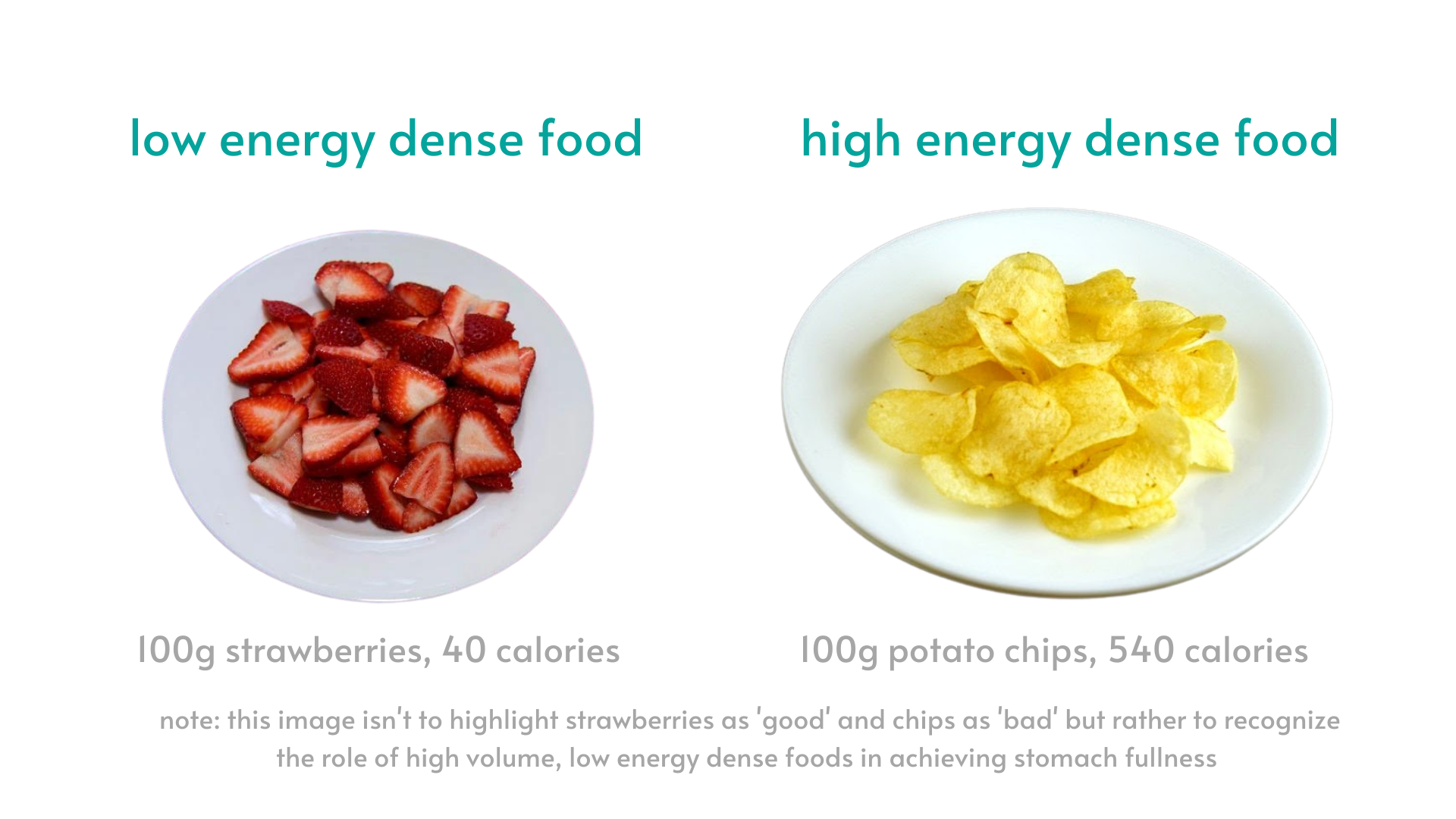
One review found that when presented with different versions of foods that are similar in palatability but that vary in caloric density, the typical respondent will consume a consistent volume of food. This means that most of us will consume the same weight in food, regardless of the caloric density of the meal. Based on this data, we see that if a client consumes a meal containing calorie-dense foods, they are likely to consume more total calories than were they to prepare a meal incorporating lower-calorie foods.
So what do we do about it? Our team of Registered Dietitians know that completely banning foods from a client's lifestyle doesn’t work and that our client's can’t always control the environments that they spend time in. Unless our nutrition coaching clients plan on living in a bubble, they need to learn how to navigate (and include) these foods in their diets while also considering their own health and wellness! While researchers have shown that it is difficult to regulate our intake of hyper-palatable, ultra-processed foods, there are ways we can adjust our choices. By building in volume foods and supporting our blood sugars we can regulate our appetite and live in balance with ultra-processed foods when we either have access to them in our environments or consciously choose to consume them.
- Build volume foods into your meal. We define volume foods as foods that are low in calories per serving and are loaded with vitamins, minerals, and antioxidants. A couple Dietitian-favourites include berries and non-starchy vegetables. By building high-volume foods into your meals you are likely to feel more full whilst consuming relatively fewer calories and benefiting from the vitamin and antioxidant profiles of these foods.
- Support your blood sugars. A mixed meal that contains high-fibre foods, proteins, and fats helps to reduce the blood sugar spike that can follow a meal, whilst increasing longer-term satisfaction. This can impact your energy levels throughout the day and reduce the subsequent cravings that may arise after consuming a higher-carbohydrate choice.
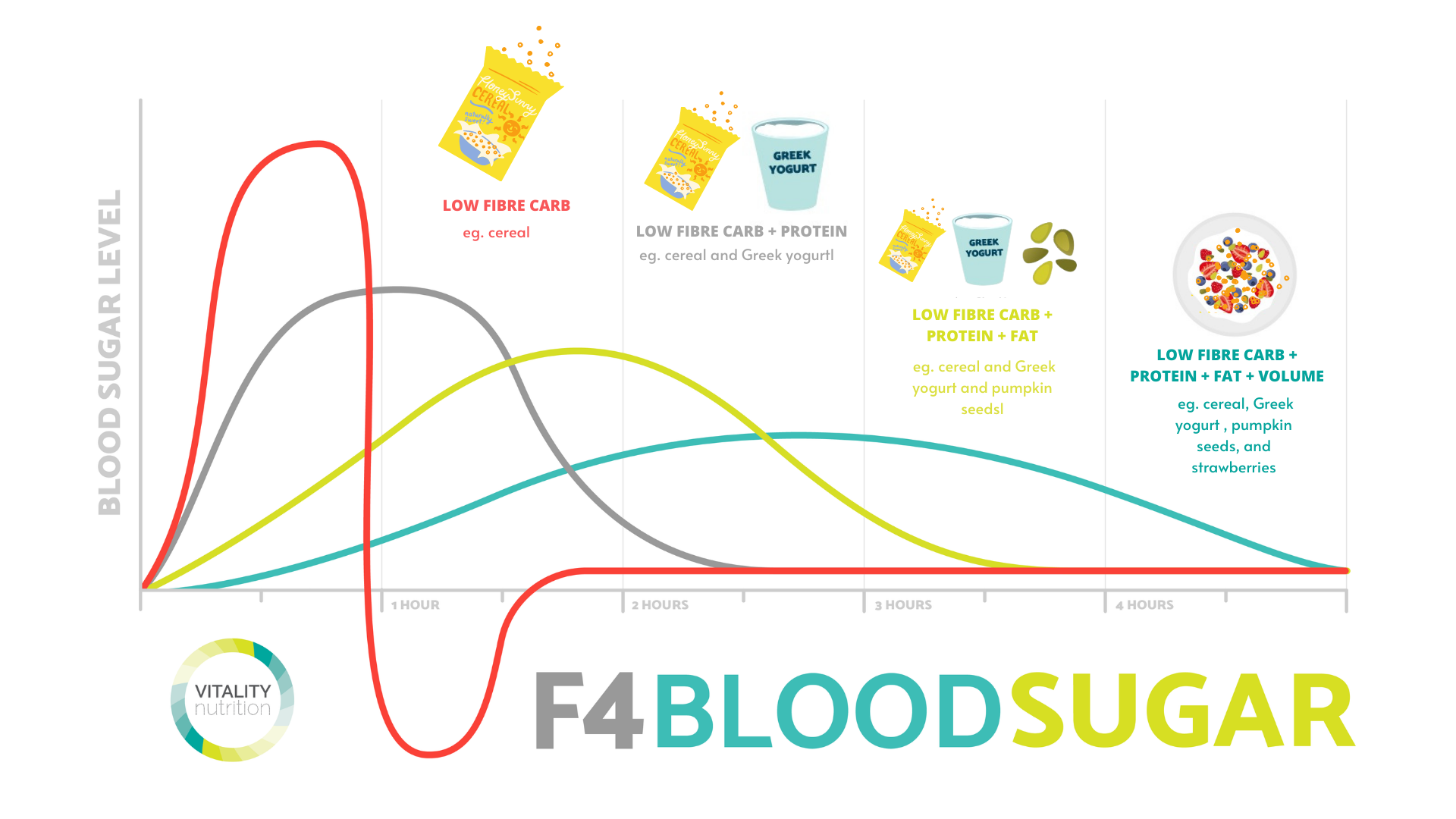
In the graphic we see that cereal alone causes a blood sugar spike which can lead to subsequent cravings, hunger, and an energy slump. Adding in plain Greek yogurt for protein, seeds for healthy fats, and berries for volume slows the release of sugar from the cereal for stable blood sugars, lasting energy, and increased satiety!
Here are a few examples of how you might incorporate ultra-processed foods in a way that prevents over-eating them:
- If you know you will be enjoying pizza for lunch, perhaps build in veggies and hummus or a salad to enjoy as part of the meal for volume, fibre, and healthy fats.
- If you are looking to enjoy a doughnut from the break-room, try eating it after a lunch that contains volume foods, protein, fibre, and fat instead of on an empty stomach which could lead to the desire to consume multiple doughnuts in order to feel satisfied.
- If you are craving nachos, try adding some lean ground beef or diced chicken for protein, chopped tomatoes and peppers for volume and fibre, grated cheese for satiating fats, and/or some black beans for more fibre!
- If you are craving chocolate, try building it into a snack with higher-volume and fibre-filled foods like chocolate with strawberries or perhaps a high protein Greek yogurt parfait with strawberries and chopped chocolate!
As Registered Dietitians, we believe it is crucial to highlight that there is certainly a time to simply enjoy the food you are craving without adjusting how you build your meal around it. For example, eating the cake you love or the chips you are craving without adding in volume, protein, healthy fats, and fibre can help 'fuel the soul' and promote a healthy relationship with food so long as this is done in reasonable moderation. Rather than thinking of our recommendations of building in volume and supporting blood sugars as 'rules', we encourage our clients to approach these strategies as tools or principles that can be used when striving to achieve a balanced approach to all foods.
TAKE ACTION
Through this discussion the Registered Dietitians at Vitality Nutrition explored how our choices are influenced by cues in our environment. Our key takeaways included:
- Intentionally crafting your environment in ways that makes supportive habits easier and unsupportive habits more difficult.
- Building or maintaining a trusting relationship to all foods through food habituation and by taking an inclusive approach to all foods.
- Living in better balance around ultra-processed foods by managing appetite and satiety signals through stress management, getting enough sleep, and balancing meals with volume foods, protein, fibre, and nutritious fats.
If you enjoyed this free content, you can support our Saskatoon-based local business by sharing this article or our podcast episode with a friend, family member, coworker, or anyone you feel would benefit from the tips and perspectives we shared in order to help build a supportive environment!
Listen to the accompanying Podcast episode on environment design here.
Ready to bring the evidence-based nutrition support of our Registered Dietitians into your kitchen?
Hungry for more?
Get recipes, tips, and updates from the Vitality Nutrition team straight to your inbox!
Don't worry, your information won't be shared.

